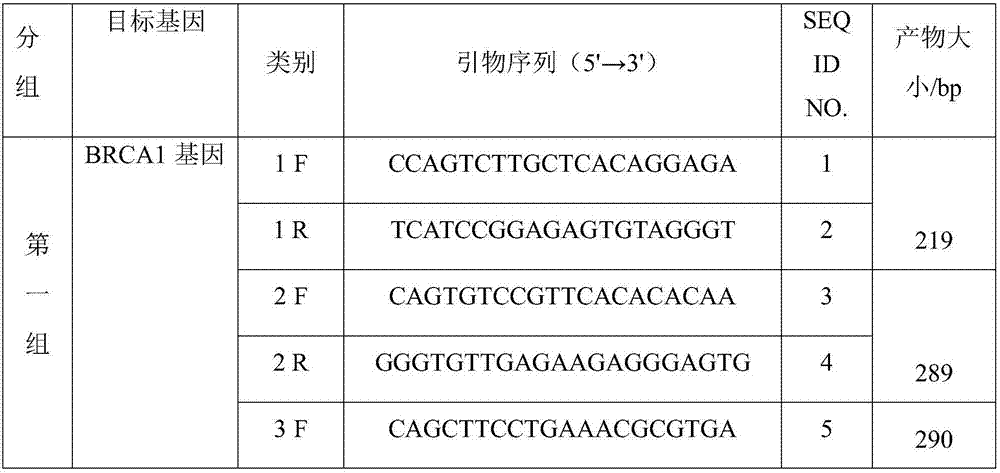Kit for detecting abnormity of BRCA1 and PTEN genes and detection method
An abnormal detection and kit technology, applied in the field of molecular biology, can solve the problems of increasing detection and waiting time for results, long probe length, etc., to shorten the time required for full hybridization, improve detection sensitivity, and improve detection efficiency. Effect
- Summary
- Abstract
- Description
- Claims
- Application Information
AI Technical Summary
Problems solved by technology
Method used
Image
Examples
Embodiment 1
[0041] Example 1 A BRCA1 and PTEN gene abnormality detection kit
[0042] The BRCA1 and PTEN gene abnormality detection kit described in this embodiment mainly includes:
[0043] 1. Design amplification primers
[0044] Design the first and second sets of amplification primers for the BRCA1 gene and the centromere region of human chromosome 17 respectively. The first group is the amplification primer for the BRCA1 gene, and the second group is for the centromere region of human chromosome 17 The corresponding amplification products constitute the first set of probe library and the second set of probe library; respectively, the third and fourth sets of amplification primers are designed for the PTEN gene and the centromeric region of human chromosome 10 , The third group is the amplification primers for PTEN gene, the fourth group is the amplification primers for the centromeric region of human chromosome 10, and the corresponding amplification products form the third group and the f...
Embodiment 2
[0075] Example 2 Using the BRCA1 and PTEN gene abnormality detection kit in Example 1 to detect clinical samples of prostate cancer patients
[0076] In this embodiment, the detection of abnormalities of BRCA1 and PTEN genes in circulating tumor cells of prostate cancer patients is taken as an example. The BRCA1 and PTEN gene abnormalities detection kit in Example 1 is used to examine peripheral blood samples of 20 prostate cancer patients. The steps are as follows:
[0077] 1. Sample pretreatment:
[0078] 1. Enrichment of circulating tumor cells: Peripheral blood samples are treated with commercially available red blood cell lysis to remove red blood cells. The blood sample and red blood cell lysate are mixed in a ratio of 1:3; the cell suspension after red blood cell lysis is added to the filter membrane ( The filter membrane has a pore size of 5-8um) and is subjected to suction filtration. After the suction filtration is completed, carefully remove the filter membrane with tweeze...
Embodiment 3
[0117] Example 3 The influence of different target gene selection on test results
[0118] 1. Detection of target gene selection
[0119] In order to test the influence of the selection of different target genes on the sample detection results, three experimental groups are designed in this embodiment, in which experimental group 1 uses all probes of the first and second groups to detect the BRCA1 gene; experimental group 2 uses the third , The fourth set of all probes detects PTEN gene; experimental group 3 uses all the first, second, third and fourth sets of probes to detect abnormalities of BRCA1 and PTEN genes in parallel. See Table 6 for specific test arrangements. The synthesis of the probe, the construction of the probe library, the labeling of the probe and the experimental procedures are as shown in Example 1 and Example 2.
[0120] Table 6 Selection of target genes
[0121]
[0122] 2. Sample detection
[0123] Using the kit prepared by the above design, according to the st...
PUM
 Login to View More
Login to View More Abstract
Description
Claims
Application Information
 Login to View More
Login to View More - R&D
- Intellectual Property
- Life Sciences
- Materials
- Tech Scout
- Unparalleled Data Quality
- Higher Quality Content
- 60% Fewer Hallucinations
Browse by: Latest US Patents, China's latest patents, Technical Efficacy Thesaurus, Application Domain, Technology Topic, Popular Technical Reports.
© 2025 PatSnap. All rights reserved.Legal|Privacy policy|Modern Slavery Act Transparency Statement|Sitemap|About US| Contact US: help@patsnap.com



